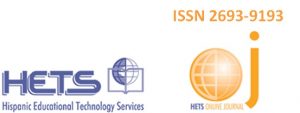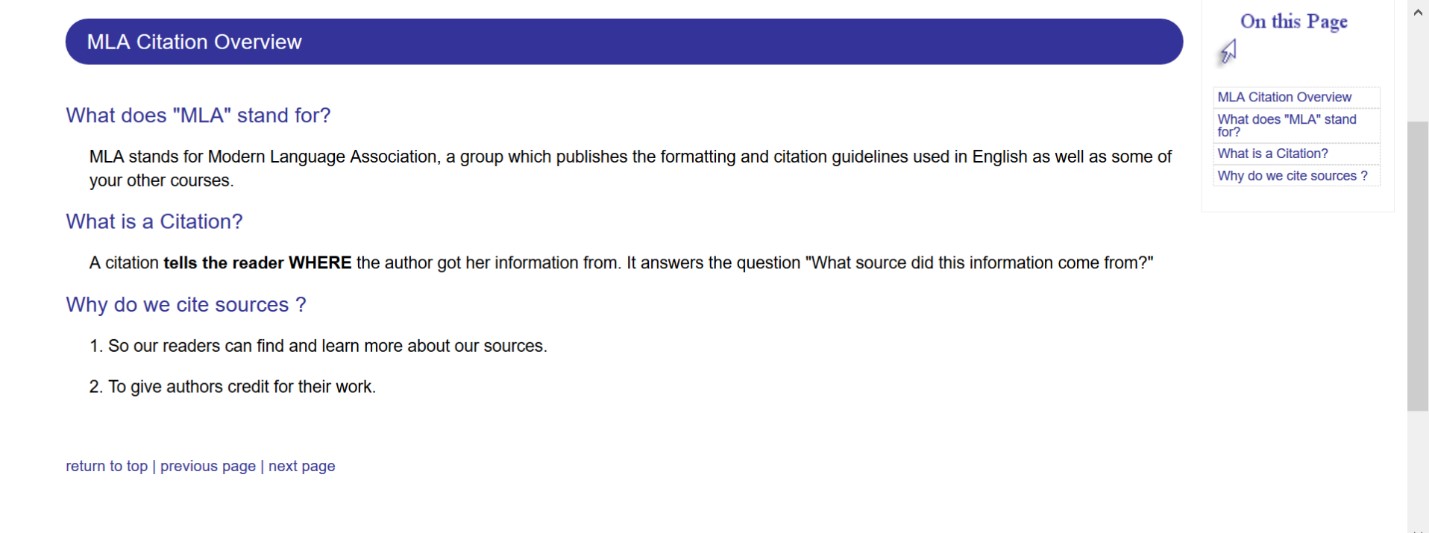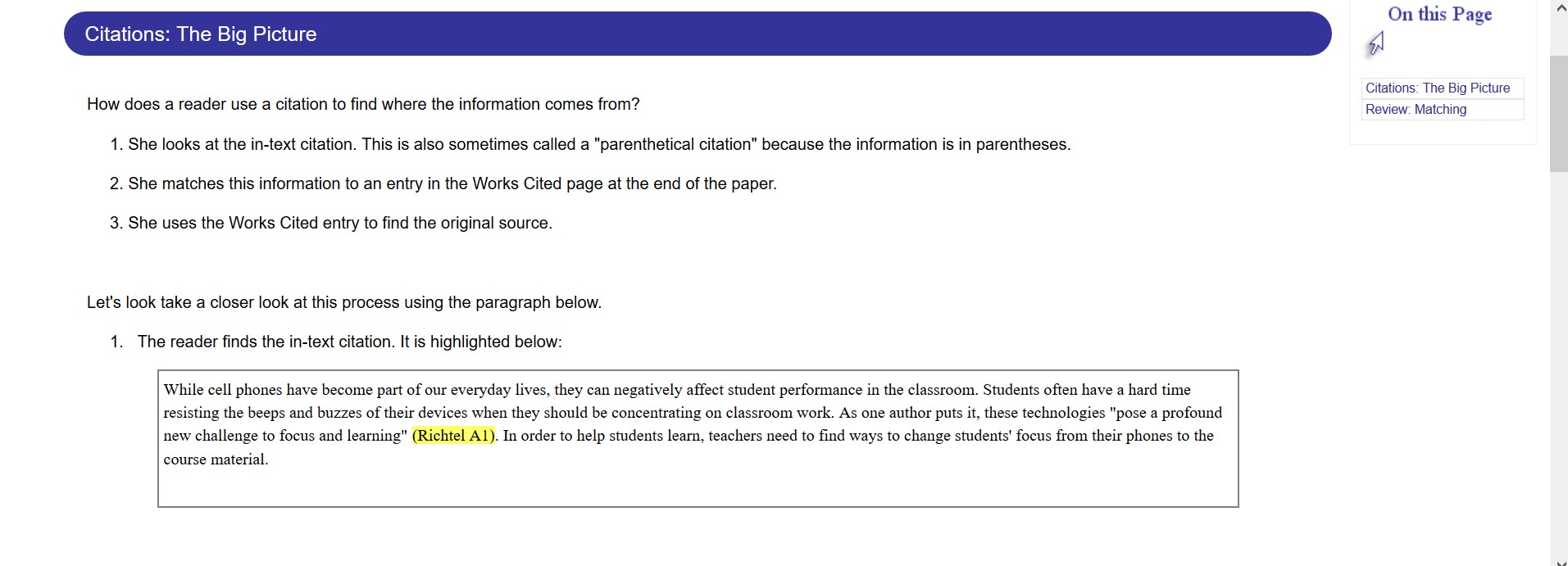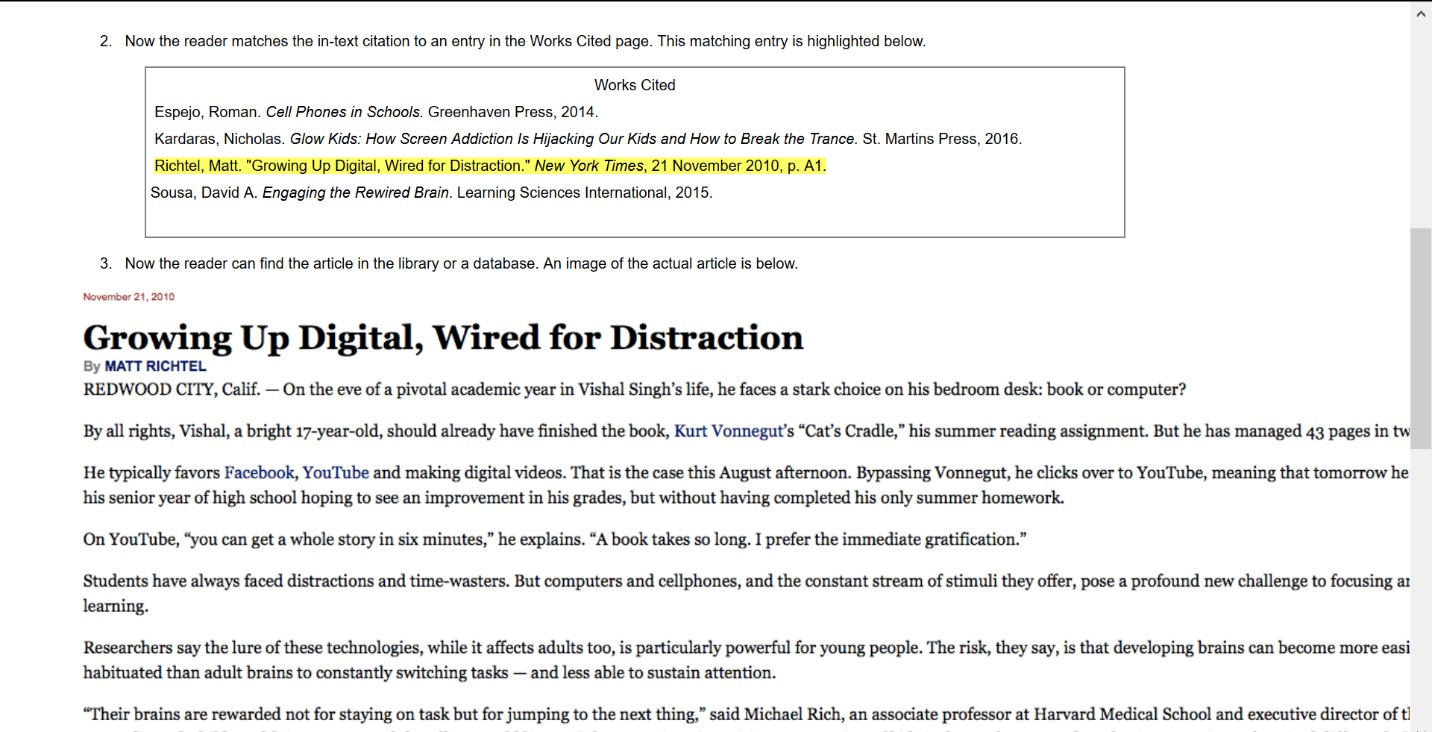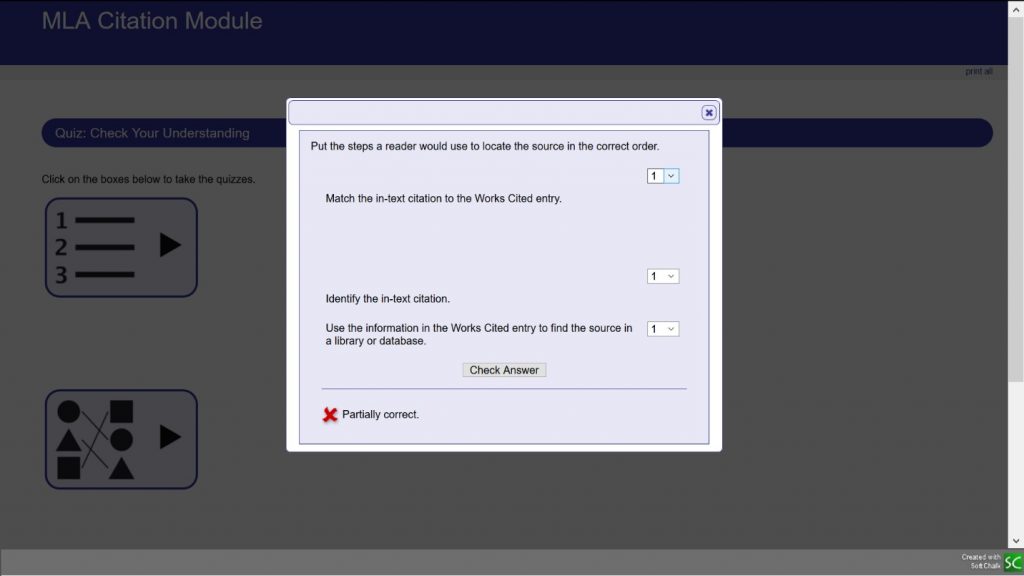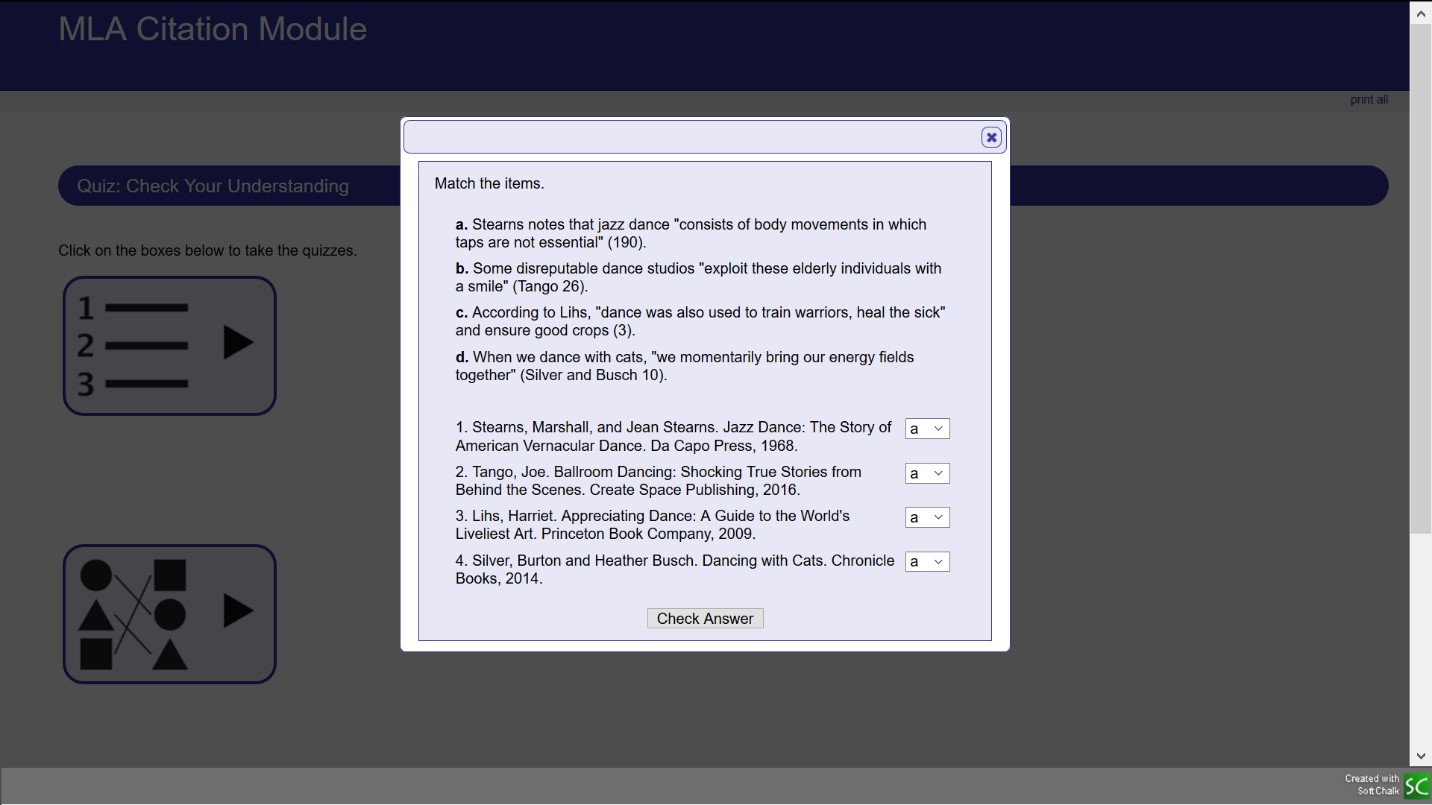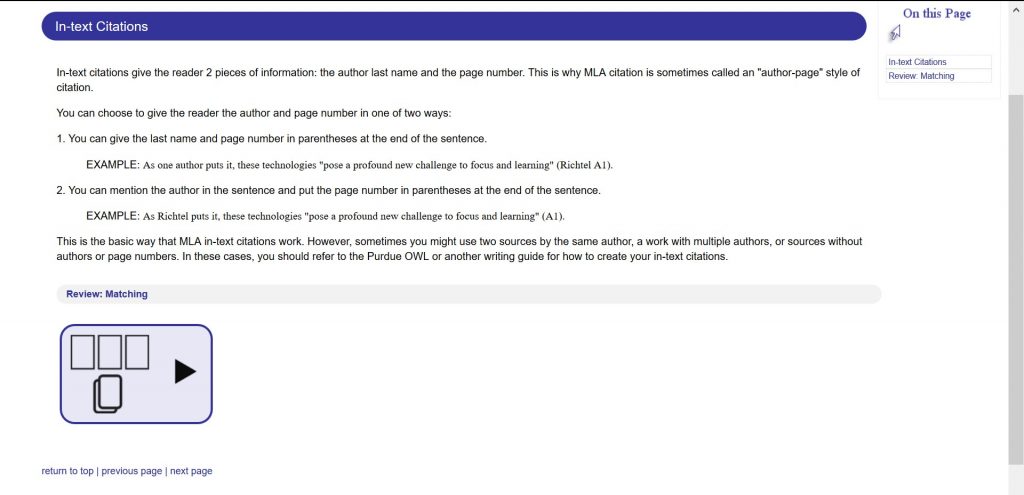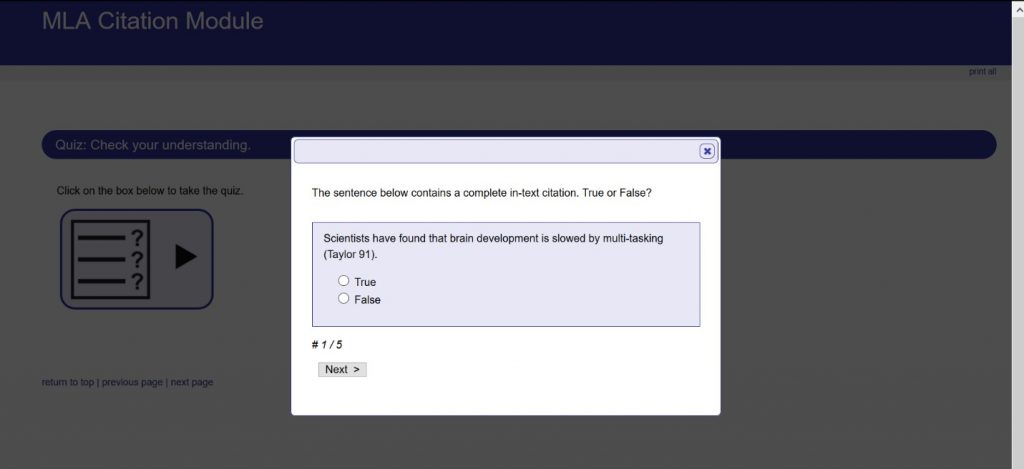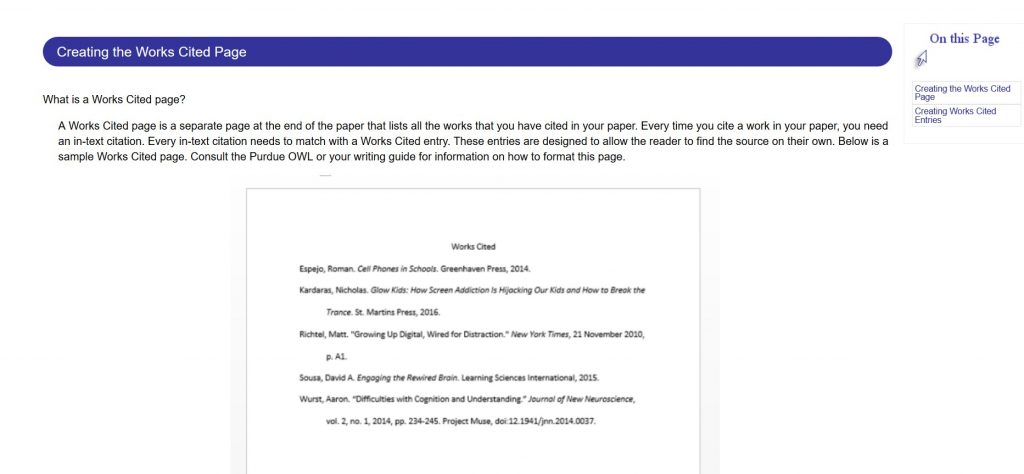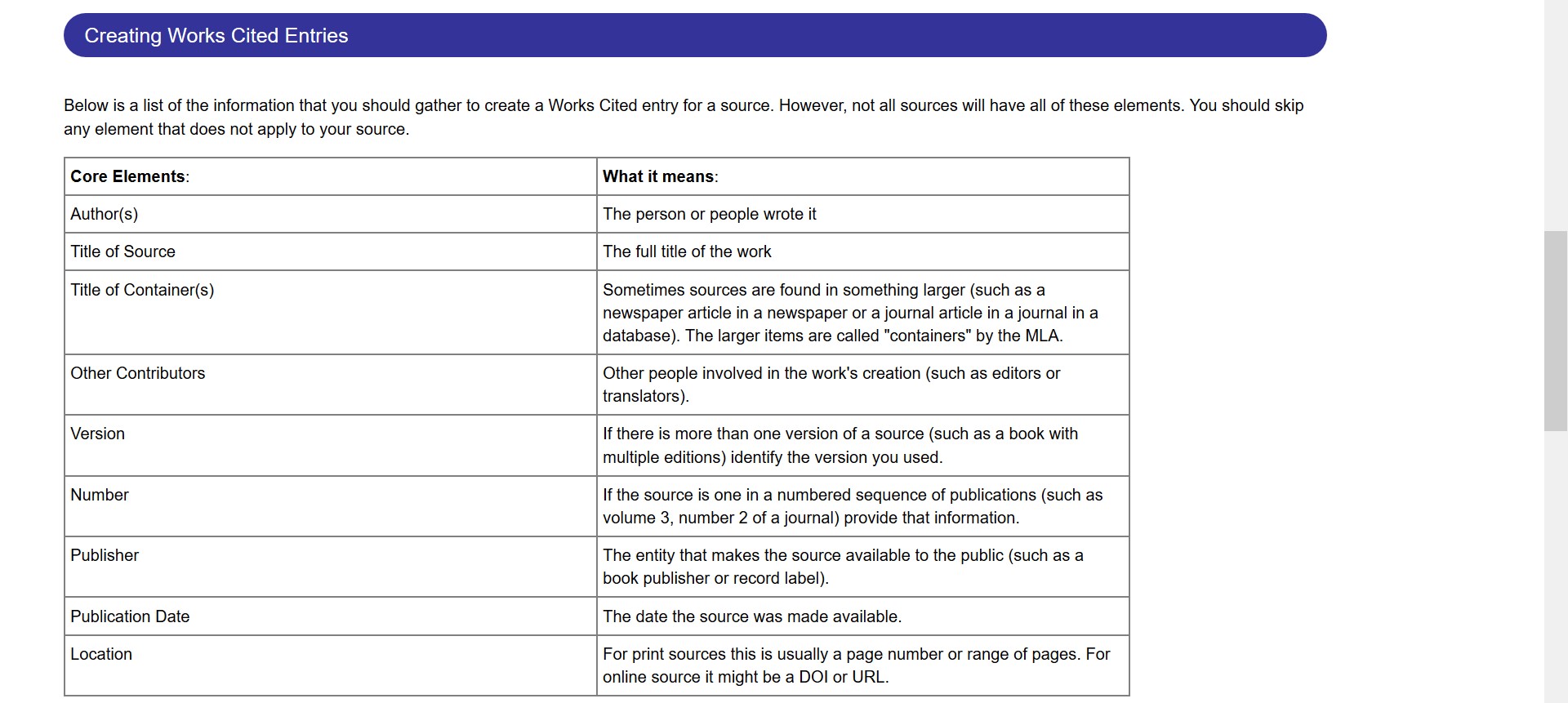Teaching with an Online MLA Citation Module at a Hispanic and Minority Serving Community College: Design, Implementation, and Results
By: Prof. Rob McAlear,
Assistant Professor, English Department, Queensborough Community College of the City University of New York (CUNY)
Abstract
This article shares the design considerations, implications, and data analysis of an MLA citation online module created using Softchalk e-learning software. Based on research on how to best meet the needs of the diverse, multilingual, and English language learner students at the author’s college, key to the module’s design was using a “flipped” approach, ease of use for students as well as faculty, multiple types of review activities, and a positive rhetorical frame of participation in a scholarly community. Statistical analysis of data collected showed the module to be effective, especially for students who knew little about MLA citation to begin with and implies that such modules may help to close gaps in student knowledge created by cultural and linguistic bias.
Introduction
In the digital age, information literacy has become crucial to both academic and workplace success (Rockman, 2003). Information literacy has been found to be positively correlated with behaviors associated with academic success such as problem solving, collaboration, and thinking critically (Gratch-Lindauer, 2007), and information literacy instruction is correlated with higher student retention and GPA (Blake et al., 2017). Moreover, research has also shown that even though information literacy can look quite different in the workplace than the classroom, employers value employees with information literacy skills (Conley & Gil, 2011; Sokoloff, 2012). In fact, information literacy is such a vital skill for students’ academic and workplace success that some researchers have called it a “new liberal art” (Shapiro & Hughes, 1996).
As defined by The Association of College and Research Libraries (ACRL), information literacy is “the set of skills needed to find, retrieve, analyze, and use information” (Association of College and Research Libraries, n.d.). According to the ACRL “Framework for Information Literacy for Higher Education,” among these skills is giving “credit to the original ideas of others through proper attribution and citation” (Association of College and Research Libraries, 2016). At many colleges required writing courses are the primary place in which students are taught to document their use of sources, but an examination of student writing across college types by the Citation Project shows that even students who use citation often struggle to fully integrate the ideas of others into their writing (Jamieson, 2017). Assuredly, as the ACRL’s “Framework” makes clear, to be information literate requires more than being able to correctly use bibliographic and in-text citation. However, while properly citing sources is no guarantee in itself of well-developed information literacy skills, citation does require that students take the time to evaluate a source’s authorship, type, and validity and at least begin to integrate sources into their work, activities crucial to information literacy development. In this sense, a student’s proficiency with citation can serve as a heuristic for college instructors to gauge a student’s information literacy development and needs.
At the large urban community college where I teach, students often arrive in first-year writing courses with minimal information literacy skills and little understanding of how to cite sources in their writing. Indeed, a recent department assessment of student papers in our 200- level English courses indicated that many students were not achieving proficiency in their use of MLA Citation. Despite these students having already completed our two-semester required writing sequence, more than half of the students failed to use citations “nearly correctly,” even when required to do so by an assignment. Instead, students often used citation either incorrectly or partially. For example, many just pasted URLs at the end of their paper or in the body of the text, attempts at citation that seem to fulfill little purpose other than avoiding a charge of plagiarism. As disheartening as these assessment results were, they motivated me to research what strategies we might use to boost the ability of our diverse student body to cite sources with the hope of also developing their overall information literacy, a skill set correlated with academic success and retention.
The research I conducted subsequent to our disappointing assessment data prompted me to design and implement an online learning module at our college in the hope that our students might better grasp the basics of MLA citation. Online learning modules, in which a sequence of topical lessons can be accessed by students online, have been shown to both reduce the amount of plagiarism in student papers (Belter & du Pre, 2009) and increase students’ understanding of information literacy (Johnston, 2010). One source of motivation for this project was the success instructors at other institutions have had teaching students citation and information literacy through online learning modules. For example, Angell (2016) successfully developed an interactive instant polling exercise to teach students citation. Likewise, though in my opinion plagiarism may not be the most effective way to frame citation practices, teachers responding to academic dishonesty problems in their own classrooms have had success developing online anti-plagiarism activities involving citation that range from matching exercises to fairly complex video games (Bradley, 2015).
Inspired by these examples and the need demonstrated by our assessment data, I set out to design a module to meet the needs of the diverse population of students at our urban community college, many of whom are English-language learners (ELL) and report having had little experience with citation in high school. Because some of our students already have negative associations with citation as a type of academic policing for plagiarism, I wanted the module to instead frame citation as a pro-social and useful practice of the scholarly community. In addition, in order to be widely used, the module needed to be easily accessible to instructors with varying levels of comfort with technology. In what follows, I present the research that guided these pedagogical and technological considerations as well as an analysis of student data collected about the module’s efficacy. My hope is that others who teach at institutions similar to my college can use the principles and experiences I had with the design and assessment of this module to help them create other instructional modules that meet the needs of their students as well as improve on the design and analysis of the module I created.
Design Considerations
The college I teach at is a Hispanic and minority serving institution where students speak 79 languages, so our courses enroll many multilingual and English language learner students (“Diversity,” 2019). When considering what form instruction in MLA citation might take, this diversity of cultural and linguistic backgrounds at our college suggested that a “flipped classroom” approach in which students are presented material at home which is then further practiced in class (Bergmann & Sams 2012) might particularly benefit our students. As Santos (2017) notes, introductory courses “can be quite challenging for ELLs who need more time to process complex concepts as they are at the same time managing the acquisition of a second language as well.” Flipping allows such students time to better comprehend new material, re-reading and paraphrasing as needed, and research has shown that this additional time benefits the ELL students we have many of in our introductory writing classrooms at my college (Kvashnina & Martynko, 2016).
Furthermore, the ability to work through material on their own may help even those students from multilingual backgrounds who do not identify as ELL. Linguistic bias in placement can result in multilingual students being placed into remedial courses, which are less likely to prepare them well for college (Roberge et al., 2009; Thonus, 2003). As a result, such students may have had less exposure to information literacy instruction. For instance, one study of the library and research habits of Hispanic college students found that more than a quarter reported doing their first research in college, with the highest incidence among those speaking Spanish at home (Haras, et al., 2008). Given the diversity of linguistic and educational backgrounds at my college, a flipped instructional approach to citation instruction made sense not only to allow ELL students time for reading comprehension, but also to allow students fluent in English but new to citation time to process content and formulate questions for their instructors.
While using a flipped approach made it clear that the module’s content needed to be online, other instructional and pedagogical considerations influenced my choice of software. I wanted the module to be broadly available for use in the department’s writing courses, so it needed to be relatively easy for instructors to integrate into their current teaching. Research shows that when teachers do not perceive technology as easy to use, they may be less likely to adopt it (Li et al., 2016). Furthermore, although most college students have access to a cellphone, students from lower-socioeconomic backgrounds are less likely to have reliable access to computers and broadband internet (Gonzales et al., 2018). Since students at my college may rely on their cell phones to access the internet, the module needed work equally as well on a cell phone as a computer and not consume much data. In addition, the software used needed to be capable of doing more than just playing a lecture conveying citation information to students. To maximize student learning, research indicates that content needs to be interspersed with opportunities to practice and apply the ideas and concepts introduced (Lumpkin et al., 2015) so the software used for the module needed to offer students a variety of ways to practice.
When considering how to rhetorically frame the content of the module itself, I chose to avoid the common practice of presenting citation primarily as a way to avoid plagiarism. The frame we choose to communicate the importance of citation to our students matters because it communicates our values (Adler-Kassner et al., 2009). Coupling citation instruction with plagiarism warnings creates anxiety in students over being accused of academic misconduct that can overshadow the scholarly purpose of citation (Buckley, 2015). From an instructional standpoint, focusing on citation as a threshold concept (i.e. a practice integral to a community) may help students to see citation as less about policing academic misconduct and more as a useful practice that helps affirm one’s part in the scholarly community (Warner, 2011). Given these considerations, I decided to create the module within a frame that understood citation as a useful community practice, emphasizing its purpose as a prosocial behavior that helps other writers within the scholarly community understand the ongoing discourses around a question or topic.
Description of the Module
After consulting with our college IT department about the licensed options available at our college, I decided to use SoftChalk software to create the MLA Citation module. Softchalk’s website describes the software as a way to “create-your-own engaging, interactive, personalized online lessons that your students can access anytime, anywhere, on any device.” While our college uses the Blackboard learning management system, many instructors in our department do not use the system, and Softchalk’s cloud feature allows users to create a URL that can be shared directly with instructors and their students, simplifying the module’s distribution. Students and faculty do not need to register, download, or pay anything to access the module through Softchalk. They can simply click on a link or paste a URL into their browser, making the module easily accessible from their phones as well as computers. Another reason, I chose Softchalk was the diversity of activities available for reviewing content. The software has multiple types of sorting and matching activities as well as quizzes. It should be noted that some of these have limited character fields, making them unsuited for certain kinds of content. Another drawback is that some of the activities do not preserve text formatting in the activity fields, meaning that MLA citation titles can be italicized when the content is presented on the main pages but not in the activities themselves. Despite these limitations, Softchalk was licensed at our school and had many of the design features I had hoped for, making it a practical choice for the purpose of the module.
The module as a whole was created to introduce students to the concept of citation, give them an overview of how readers use citations, and then teach the basics of MLA in-text and bibliographic (i.e. the Works Cited page entries) citations. The module divides these topics into four sections, each with a practice activity like sorting cards or dragging bibliographic citations to their matching in-text citations as well as a short review quiz. In the first section (Figure 1, 2, below) students are told what MLA stands for and that citations tell the reader where information comes from and give credit to an author. This is followed by a short matching quiz.
Figure 1. The first section of the module giving an overview of citation.
The second section, called “Citations: The Big Picture,” walks students through how to use an in-text citation to find a Works Cited entry and then the source itself. The page presents them with the steps a reader would take and then has a sample in-text citation from a paper, its Works Cited entry, and an excerpt of the newspaper article itself.
Figure 2. The second section of the module showing the process a reader uses to locate an article from an in-text citation.
Figure 3. The citation location process continued.
This information is followed by a drag and drop matching activity and two short review quizzes. All of these activities are self-checked by students.
Figure 4. Drag and drop review activity.
Figure 5. Check Your Understanding Self-test
Figure 6. Second Check Your Understanding Self-test
The third section covers in-text citations in more detail, including how to cite when an author’s name is included in a sentence. There is then a card sorting activity and another review quiz.
Figure 7. Part 3. The basics of in-text citations.
Figure 8. In-text citation card sorting activity
Figure 9. In-text citation true/false self-quiz.
The final section shows students the possible information categories for the Works Cited page in a table and then completes the table for the sample newspaper article. Each entry is color-coded so that students can see how the entries in the table correspond to each part of the Works Cited entry. The module then ends with a final quiz and a completion screen.
Figure 10. A sample works cited page is presented first so students can see what the end-goal is.
Figure 11. A list of possible information fields for creating a works cited page with explanations.
Figure 12. Information table with color coded works cited fields that correspond to the entry.
Figure 13. Final quiz
Pre and post-test data collection and analysis
Because the module was intended to help close the loop on our department’s assessment of student citation practices, the college’s assessment office suggested that data be collected to determine whether the module improved student understanding of citation. To this end, I created a multiple choice test with 5 questions (Table 1) in Blackboard that could be administered before and after the students took the module.
The questions were designed to ascertain students’ understanding of the basics. The first two questions were intended to test students understanding of the community aspects of citation. The final three questions were derived from the issues common to the departmental assessment data: missing or incorrectly placed Works Cited pages and issues with in-text and Work Cited citations. The test was kept simple and short so students would focus on the module itself.
I next solicited faculty volunteers from the English department to assign the module and the tests to their classes. The questions were assigned 10 points each and the data was collected automatically through Blackboard. Data was collected from English 101 and 102, the college’s required writing courses, as well as department’s 200 level writing intensive literature courses. The data was then provided to me anonymously by instructors for assessment purposes. [1]
After eliminating students who did not take the post-test, pre and post-test scores were collected from 125 students. Next a paired t-test was conducted to calculate a two-tailed p value. Table 2 shows the pre- and post-test means, standard deviation, and significance (p) for all courses, as well as for English 101, 102, and 200 level courses individually. A separate calculation was also done for student in all courses who scored a 30 or below on the pre-test. Statistical significance of p < .05, was reached for all data.
Discussion
Given that the pre- and post-tests were taken immediately before and after students completed the module, the “all courses” data indicates that the module had a significant effect on students’ ability to answer some basic questions about MLA citation. The greatest improvement could be seen for those students who scored a 30 or lower, a group which, after completing the module, came close to the mean post-test score of those who scored 40s and 50s on the pre-test.
Although the module seems to have been a helpful review even for students who started out with basic knowledge about citation, it dramatically worked to level the playing field for those students with less knowledge of or exposure to MLA citation in previous writing courses. Helping these students to get caught up to their peers also has advantages for instruction. The module’s ability to get most students on the same page before class allows for greater instructional time in the classroom to be spent on practicing and problem solving citation skills rather than presenting content and answering questions. Given the linguistic and cultural bias that may result in minority and ELL students having less exposure to citation when they arrive on campus, the success of the MLA module for those originally least aware of citation suggests that instructional modules using a flipped approach may be a helpful tool not only to improve students’ understating of MLA citation, but to help overcome such educational inequalities across the curriculum.
When broken down by course, the data confirm to some degree what one might expect: the module is more important and useful for students enrolled in my college’s first semester writing course English 101 than for those in English 102. 101 students not only had lower total means on their pretest, 36% of them got a 30 or below compared with only 15% of 102 students. The data indicate that about a third of English 101 students seem to have had limited prior exposure to MLA citation. This could be due to, among other things, the differing high school experiences students had in other countries where MLA citation is not used, linguistic bias placing multilingual students in remedial courses that did not emphasize citation, and a higher percentage of returning and non-traditional students, most of whom have not taken a writing course since high school. 102 students, in contrast, are likely to have received instruction and been able to practice MLA citation more recently in their required 101 courses.
However, 200-level students, who have already passed both 101 and 102 did less well on the pre-test than students in either of the introductory courses. This supports the finding of the original 200-level assessment data that students in these courses were not using citation proficiently. More research would be needed to ascertain the reason for this discrepancy, but one cause may be the often long delay between students finishing their required writing sequence and taking 200-level elective courses. If this is the case, students may benefit from using the module as a citation review early in the semester in 200-level English courses. Furthermore, writing intensive courses in other disciplines should consider using discipline specific citation modules to encourage students to practice their information literacy skills across the curriculum.
Limitations and Areas for Further Study
Interestingly, the mean pre-test results for all groups were quite high relative to the original assessment data collected. This may be due to the guardrails effect of a multiple choice test, where students who did not know or were unsure of an answer could guess, or it may be due to the test itself being too simple or too short because the test was designed to check for general efficacy for assessment purposes rather than more granular research. Furthermore, although questions were written based on the common student errors in the department’s 200-level course assessment, perhaps many students understand citation adequately enough to do well on a test but remain unable to properly implement it in their papers. If so, this underscores the need for the module to be followed with students practicing citations in both exercises and their own writing. While fill in the blank type exercises in the module itself would have given students a better chance to practice, both the Softchalk software and Blackboard have limited possibilities for automatic correction of fill in the blanks, making the best solution still instructor feedback.
While the data show the MLA module had a statistically significant effect on student’s understanding of MLA citation, more research is needed to determine the persistence of this effect and its transferability to actual student writing. To determine if the improvement shown on the module persisted over time, one could both administer a second post-test at the end of the semester and also collect and evaluate paper samples from module and non-module courses. In such a case it would be difficult to account for the effect of individual teachers’ instructional methods, but collecting this data would provide a more complete picture of students’ difficulties and assist with subsequent revisions of the module. Conducting instructor interviews about the additional instruction and practice done in their classes would also present a more complete context of how teachers are using the module, and how it might best support students’ long-term understanding of MLA citation. Such data would allow for the development of a companion lesson plan to accompany the module that would use active learning and problem solving pedagogy to reinforce the content covered in the module and give students opportunities for practice.
Implications and Conclusion
Though this module was designed to meet the needs of students at our large urban community college, many of the principles and lessons learned from its design may be of use to teachers at other community colleges and Hispanic, and minority-serving institutions. The data collected on the MLA Module indicated it was successful in introducing students to the basics of citation and most successful for those who started out with the least deficit. One of the challenges of teaching introductory courses at open-enrollment institutions is the varied background knowledge of the students. Flipping the classroom by using modules like the one here can meet the critical need to level the playing field for those ELL and multilingual students encountering concepts like citations for the first time or in a language in which they may be still acquiring proficiency as well as for students who have taken years off and may need a refresher. The successful results of this module call for other campuses, especially community colleges and minority-serving institutions, to develop and test the efficacy of information literacy materials, like this module, that speak to these students’ needs in particular.
Flipping the classroom using online learning modules such as the one discussed here can give students the opportunity to encounter material at a pace that works for them, allowing them to work independently to build confidence and understanding before being asked to perform in the classroom. At the same time, online modules give instructors more valuable class time to work with students on practicing these skills, something often in short supply on campuses like my college where many students, because of life and work demands, do not attend office hours because they are able to spend little time other than for classes on campus. Further research would be needed to test for the effect of such instruction on retention and academic success, but it seems probable that providing students who need it with a way to level the playing field would help them persist in their studies.
The research I conducted into the module’s design also implies that greater care should be taken as to how teachers are framing the content and skills they want students to learn. For example, citation should be framed as a helping readers and being part of a community rather than giving credit and preventing cheating. For students who already feel excluded from academia because of their linguistic, cultural, or familial backgrounds, an invitation to become part of a scholarly community may position them to better succeed in their coursework and persist as students than rather than being policed for plagiarism. In addition, when students see citation as only about avoiding plagiarism, they may be more likely to only do the minimum to avoid this charge, like pasting URLs into the text. Thus, attention to rhetorical framing has the potential to make learning more inclusive and help students to better learn the material.
While this module was a locally created as an attempt at addressing a departmental assessment finding, it has now become a teaching resource widely used by instructors in our department. The success of this module has convinced me to approach the library faculty at my college to develop other online learning tools that address the information literacy and writing needs of our diverse student body, and I hope by sharing this example, I may inspire others to do the same.
References
Adler-Kassner, L., Anson, C.M., & Howard, R.M. (2009). Framing plagiarism. In C. Eisner, & Eisner, & M. Vicinus (Eds.), Originality, Imitation, And Plagiarism: Teaching Writing In The Digital Age (pp. 231-246). University of Michigan Press,
Angell, K. (2016). America’s Next Top Citation: Teaching MLA skills to students. College & Research Libraries News, 77(9), 452-455. https://doi.org/10.5860/crln.77.9.9555
Association of College and Research Libraries. (n.d.-a). Information Literacy Glossary. http://www.ala.org/acrl/issues/infolit/overview/glossary
Association of College and Research Libraries. (n.d. -b). Framework for Information Literacy for Higher Education. http://www.ala.org/acrl/standards/ilframework
Belter, R. W., & du Pré, A. (2009). A strategy to reduce plagiarism in an undergraduate course. Teaching of Psychology, 36(4), 257–261. https://doi.org/10.1080/00986280903173165
Bergmann, J., & Sams, A. (2012). Flip your classroom: Reach every student in every class every day. International Society for Technology in Education.
Blake, J., Bowles-Terry, M., Pearson, N.S. and Szentkiralyi, Z. (2017). The impact of information literacy instruction on student success: a multi-institutional investigation and analysis. Central Universities Library Research 1-27. http://scholar.smu.edu/libraries_cul_research/13/
Bradley, E. G. (2015). Using computer simulations and games to prevent plagiarism. Journal of Education Technology, 44(2), 240-252.
https://doi.org/10.1177/0047239515617653
Buckley, C. (2015). Conceptualising plagiarism: using Lego to construct students’ understanding of authorship and citation. Teaching in Higher Education, 20(3), 352-358. https://doi.org/10.1080/13562517.2015.1016418
Conley, T., & Gil, E. (2011). Information literacy for undergraduate business students: Examining value, relevancy, and implications for the new century. Journal of Business & Finance Librarianship, 16(3), 213–228. https://doi.org/10.1080/08963568.2011.581562
“Diversity…[rest of entry removed for anonymity]
Gonzales, A. L., McCrory Calarco, J., & Lynch, T. (2018). Technology problems and student achievement gaps: A validation and extension of the technology maintenance construct. Communication Research. https://doi.org/10.1177/0093650218796366.
Gratch-Lindauer, B. (2007). Information literacy-related student behaviors: Results from the NSSE items. College & Research Libraries News, 68(7), 432-441. https://doi.org/10.5860/crln.68.7.7838
Haras, C., Lopez, E. M., & Ferry, K. (2008). (Generation 1.5) Latino students and the library: A case study.” The Journal of Academic Librarianship, 34(5), 425–433. https://doi.org/10.1016/j.acalib.2008.06.004
Jamieson, S. (2017). What the citation project tells us about information literacy in college composition. In B. D’Angelo, S. Jamieson, B. Maid, & J.R. Walker, J. R. (Eds.), Information literacy: Research and collaboration across disciplines (pp. 115-138). WAC Clearinghouse & University Press of Colorado.
Johnston, N. (2010). Is an online learning module an effective way to develop information literacy skills? Australian Academic & Research Libraries, 41(3), 207–218. https://doi.org/10.1080/00048623.2010.10721464
Kvashnina, O.S., & Martynko, E.A. (2016). Analyzing the potential of flipped classroom in
ESL teaching. International Journal of Emerging Technologies in Learning, 11(3), 71-73.
http://dx.doi.org/10.3991/ijet.v11i03.5309 O.S.
Li, K., Li, Y., & Franklin, T. (2016). Preservice teachers’ intention to adopt technology in their future classrooms. Journal of Educational Computing Research, 54(7), 946–966. https://doi.org/10.1177/0735633116641694
Lumpkin, A. L., Achen, R. M., & Dodd, R. K. (2015). Student perceptions of active learning. College Student Journal, 49(1), 121–133.
Roberge, M., Siegal, M., & Harklau, L. (2009). Generation 1.5 in college composition: Teaching academic writing to U.S.-educated learners of ESL. Routledge.
Rockman, Ilene. (2003). Information literacy, a worldwide priority for the twenty-first century. Reference Services Review. 31. 209-210. https://doi.org/10.1108/00907320310486791.
Santos, M. (2017). An online tutorial in support of english language learners. Hispanic Educational Technology Services Online Journal, 8(1). http://hets.org/ejournal/2017/11/15/an-online-tutorial-in-support-of-english-language-learners/
Shapiro, J.J. & Hughes, S.K. (1996). Information literacy as a liberal art: Enlightenment proposals for a new curriculum. Educom Review, 31(2), 31-36. https://www.educause.edu/ir/library/html/erm/31231.html.
Sokoloff, J. (2012). Information literacy in the workplace: Employer expectations. Journal of Business & Finance Librarianship, 17(1), 1–17. https://doi.org/10.1080/08963568.2011.603989
Thonus, T. (2003). Serving generation 1.5 learners in the university writing center. TESOL Journal, 12(1), 17–24. https://doi.org/10.1002/j.1949-3533.2003.tb00115.x
Warner, R. (2011). Referencing as a threshold concept. The American University in Cairo TESOL Journal, Special Issue for the Nile TESOL Skills Conference Proceedings, 141-146.
[1] Subsequently, my college IRB board retroactively approved the use of this anonymous data for publication.
Trackback from your site.
